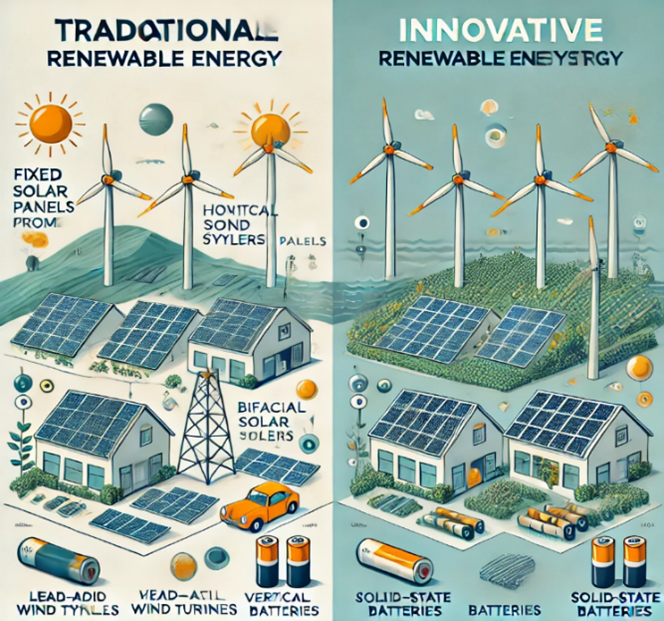Innovations in Solar and Wind Power
Green Technology ?? Comments 11/Apr/2025 FriSolar and wind power technologies are evolving rapidly, driven by the need for greater efficiency, versatility, and environmental adaptability. Innovations like floating solar panels, bifacial solar modules, and vertical-axis wind turbines are making renewable energy more accessible and effective in diverse settings. These advancements are helping individuals, businesses, and communities maximize energy generation and reduce their carbon footprints.
Details
-
Floating Solar Panels
o What They Are: Floating solar panels, also known as floatovoltaics, are photovoltaic systems installed on bodies of water such as reservoirs, lakes, and even oceans.
o Advantages:
-
Efficient Use of Space: Floating solar systems make use of underutilized water surfaces, preserving land for other uses.
-
Improved Efficiency: Water cools the panels, improving performance and reducing degradation caused by heat.
-
Reduced Evaporation: Floating panels shade the water surface, minimizing evaporation, which is especially beneficial in arid regions.
o Applications:
-
Ideal for regions with limited land availability.
-
Frequently installed on reservoirs near hydroelectric dams to complement energy generation.
-
-
Bifacial Solar Modules
o What They Are: Bifacial solar panels generate power from both sides of the panel, capturing direct sunlight on the top surface and reflected sunlight on the underside.
o Advantages:
-
Increased energy output compared to traditional single-sided panels, especially in environments with reflective surfaces like snow, sand, or light-colored roofs.
-
Durable and longer-lasting due to advanced materials used in construction.
o Applications:
-
Roof-mounted systems in residential and commercial buildings.
-
Ground-mounted systems in open areas with reflective surfaces.
-
-
Vertical-Axis Wind Turbines (VAWTs)
o What They Are: Unlike traditional horizontal-axis wind turbines (HAWTs), vertical-axis wind turbines have blades that rotate around a vertical axis, making them more compact and versatile.
o Advantages:
-
Operate effectively in lower wind speeds and turbulent wind conditions, making them ideal for urban and residential settings.
-
Quieter and less visually intrusive than traditional turbines, improving community acceptance.
-
Easier to install and maintain due to their compact design and ground-level components.
o Applications:
-
Urban environments, where space and wind direction variability are challenges.
-
Small-scale installations for homes, schools, or businesses.
-
Additional Innovations in Solar and Wind Power
-
Perovskite Solar Cells:
o A promising solar technology that uses a perovskite-structured compound as the light-harvesting layer.
o Advantages: High efficiency, lightweight, and low-cost manufacturing compared to traditional silicon panels.
-
Solar Windows:
o Transparent solar panels that can be integrated into windows, enabling buildings to generate electricity while maintaining natural light.
-
Offshore Wind Turbines:
o Larger, more powerful turbines designed for installation in deep waters, where wind speeds are higher and more consistent.
o Floating offshore wind farms are enabling installations in areas previously inaccessible to traditional fixed-base turbines.
Practical Example
Installing Bifacial Solar Panels for Enhanced Energy Generation
• Scenario: A homeowner in a suburban area decides to upgrade their solar system to maximize energy generation.
• Solution: They install bifacial solar panels on their south-facing roof, which reflects sunlight from its light-colored surface onto the underside of the panels.
• Steps Taken:
-
The homeowner selects bifacial panels with advanced glass-on-glass construction for durability and enhanced performance.
-
The system is installed with optimal tilt angles to maximize exposure to both direct sunlight and reflected light.
-
Monitoring software tracks the additional energy generated by the panels’ underside, providing insights into the system’s performance.
• Results:
o The bifacial panels generate 15%-20% more energy compared to traditional single-sided panels, lowering the household’s electricity bills significantly.
o Over the course of a year, the system produces enough surplus energy to offset the homeowner’s upfront costs through net metering credits.
Key Benefits of Emerging Energy Storage Technologies
-
Enhanced Energy Efficiency: Advanced technologies like bifacial solar panels and perovskite cells maximize energy output, making renewable systems more cost-effective.
-
Space Optimization: Floating solar panels and compact vertical-axis wind turbines enable renewable energy generation in areas with limited land availability or unique challenges.
-
Adaptability to Diverse Environments: New technologies are tailored to operate in urban settings, harsh climates, and offshore locations, broadening the applicability of renewable energy systems.
-
Lower Environmental Impact: Innovations such as floating solar panels reduce water evaporation and land disturbance, making renewable energy even more sustainable.
-
Cost Savings: Improved efficiency and durability of systems like bifacial panels and VAWTs lower long-term costs for households, businesses, and utilities.
By adopting innovative technologies like floating solar panels, bifacial modules, and vertical-axis wind turbines, households and communities can harness renewable energy more effectively, paving the way for a sustainable and energy-efficient future.
• Diagram showing traditional vs innovative renewable energy systems.
o Traditional: Fixed solar panels capturing sunlight from one angle.
o Innovative: Bifacial solar panels capturing sunlight from both sides.
o Traditional: Horizontal-axis wind turbines requiring high wind speeds.
o Innovative: Vertical-axis wind turbines operating in low wind speeds.
o Traditional: Lead-acid batteries for energy storage.
o Innovative: Solid-state batteries with higher efficiency and safety.

Tags: energy technology